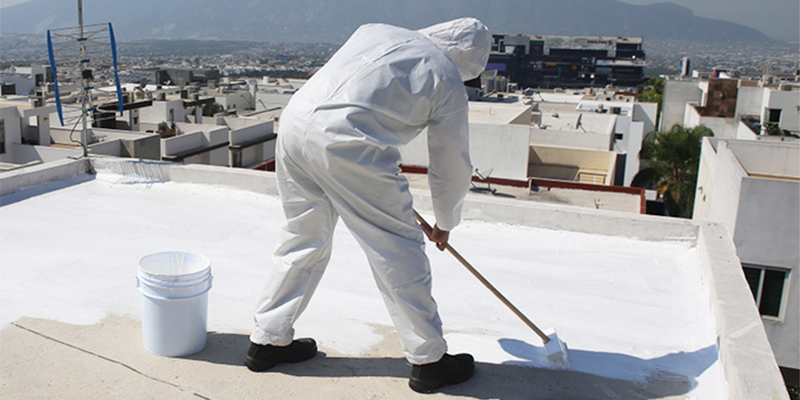
Does roof cooling paint reduce the temperature?
Yes, roof cooling paint can significantly reduce roof surface temperature. Concrete roofs tend to absorb and retain heat, making indoor spaces uncomfortably warm and increasing air conditioning costs. Reflective roof cool coating, also known as roof cooling paint, work by reflecting a large portion of sunlight and reducing heat absorption. This leads to lower roof surface temperatures, improved indoor comfort, and enhanced energy efficiency.
To further boost results, consider combining cooling paint with green roof systems, cool roof materials, proper insulation, and natural ventilation techniques.
Why Concrete Roofs Get Hot?
Concrete is a dense material with low porosity, allowing heat to transfer quickly. This characteristic causes concrete roofs to absorb and retain heat for long periods of time, even after sunset. As a result, the heat absorbed during the day is radiated into the building, leading to elevated indoor temperatures. This phenomenon contributes to discomfort and increased cooling costs, highlighting the need to address heat transfer in concrete roofs.
Strategies to Reduce Heat from Concrete Roofs
Here are 5 strategies to reduce heat from a concrete roof –
Reflective Roof Coatings
Applying reflective roof cool coating can reduce heat absorption by reflecting sunlight. Concrete roofs, under direct sunlight, can reach temperatures of 150°F or more on a sunny summer afternoon. However, by applying reflective coatings, these roofs can stay more than 50°F (28 °C) cooler under the same conditions. These coatings reflect a significant portion of the sunlight, preventing the roof from absorbing excessive heat. This not only keeps the roof itself cooler but also helps maintain lower temperatures inside the building, reducing the reliance on air conditioning and lowering energy costs.
Green Roof Systems
Installing a green roof involves planting vegetation on the roof surface. Green roofs can significantly reduce roof temperatures, with temperatures being 30–40°F lower than those of conventional roofs. Additionally, green roofs can help reduce city-wide ambient temperatures by up to 5°F, contributing to a cooler urban environment and mitigating the heat island effect.
Cool Roof Materials
Cool roof materials are designed with high solar reflectance and thermal emittance properties. In non-air-conditioned residential buildings, cool roofs can lower maximum indoor temperatures by 1.2–3.3°C (2.2 to 5.9°F). These materials reflect sunlight and emit absorbed heat, keeping the roof and the building cooler. By using cool roof materials, building owners can reduce energy consumption for cooling and improve indoor comfort levels.
Roof Insulation
Adding insulation under the roof surface can reduce heat transfer, lowering heat gain by 15 per cent to 20 per cent. This insulation helps maintain a more consistent indoor temperature, reducing the load on air conditioning. By reducing heat transfer through the roof, insulation can improve energy efficiency and comfort levels in buildings.
Natural Ventilation
Installing vents or openings in the roof allows hot air to escape, improving airflow and reducing heat buildup under the roof. Natural ventilation allows for significant air change rates (20–50 ach) for heat removal with minimal operation costs. This can help regulate indoor temperatures and reduce the need for mechanical cooling systems, leading to energy savings and enhanced comfort.
How HeatCure can Help You?
HeatCure offers innovative heat-resistant solutions to combat heat gain in buildings, specializing in rooftop coating and transparent heat-resistant glass coating. Our rooftop cool coating solutions are designed to reduce roof temperatures significantly, keeping your building cooler and reducing the need for excessive air conditioning.
With our transparent glass coating solution, you can block up to 85% of heatwaves outside, allowing 75% more natural light to enter your space while keeping it up to 20 degrees cooler. This not only enhances your indoor comfort but also helps you save on electricity bills by maintaining steady temperatures.
At HeatCure, we are committed to providing sustainable and cost-effective solutions to improve your living and working environment. Contact us today to learn more about how HeatCure can help you!
Conclusion
Implementing strategies such as reflective coatings, green roofs, cool roof materials, insulation, and natural ventilation can effectively reduce heat from concrete roofs. These strategies can significantly lower temperatures, improve indoor comfort, and reduce the need for excessive air conditioning. We encourage you to consider these strategies to improve comfort and energy efficiency in their buildings. By taking proactive steps to reduce heat gain, individuals can create more sustainable and comfortable living and working environments.



Comment (0)